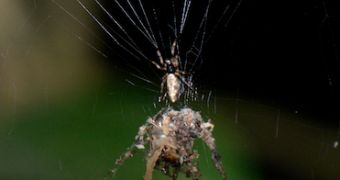Biologists investigating the Peruvian Amazon's biodiversity now claim that they found a new species of spider whose defense mechanisms are nothing if not highly innovative.
Thus, it seems that this Amazonian arachnid makes sure it does not get eaten not by hiding under a rock or in a nearby bush, but by confusing predators.
In order to do so, the arachnid collects leaves, dead insects and other debris it happens to find in its proximity, and uses them to “engineer” replicas of itself.
After it finishes making these decoy spiders, it hangs them in its web. Seeing how the fake arachnids are slightly bigger than itself, odds are that predators will decide to go for what they consider to be the obvious kill and ignore the real arachnid.
Commenting on this spider's behavior, biologist and science educator Phil Torres said that, “It seems like a really well evolved and very specialized behavior.”
Furthermore, “Considering that spiders can already make really impressive geometric designs with their webs, it’s no surprise that they can take that leap to make an impressive design with debris and other things.”
As explained on Wired, this is not the first time when various species of arachnids are found to possess rather impressive sculpting skills, yet specialists explain that this Amazonian spider is the first one observed to build a well put together replica of itself, multiple legs included.
“I have never seen a structure just like this,” stated William Eberhard, an entomologist presently working with the Smithsonian Tropical Research Institute and the University of Costa Rica.
The researchers who studied both this spider and its unusual behavior base their assumption that it is a new species on the fact that its elaborate defense mechanism has not yet been documented, and nobody could have possibly become acquainted to it without feeling the need to share their findings with others.
“The odds are that this [species] is unidentified, and even if it has been named, that this behavior hasn’t previously been reported,” believes arachnologist Linda Rayor of Cornell University.

 14 DAY TRIAL //
14 DAY TRIAL //